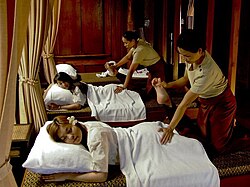Traditional Thai massage or Thai yoga massage is a traditional therapy combining acupressure, Indian Ayurvedic principles, and assisted yoga postures.[1] In the Thai language, it is usually called nuat phaen thai (Thai: นวดแผนไทย, pronounced [nûa̯t pʰɛ̌ːn tʰāj]; lit. 'Thai-style massage') or nuat phaen boran (นวดแผนโบราณ, [nûa̯t pʰɛ̌ːn bōːrāːn]; lit. 'ancient-style massage'), though its formal name is nuat thai (นวดไทย, [nûa̯t tʰāj]; lit. 'Thai massage') according to the Traditional Thai Medical Professions Act, BE 2556 (2013).[2]
| Nuad Thai, traditional Thai massage | |
|---|---|
 Thai massage | |
| Country | Thailand |
| Domains | Knowledge and practices, social practices |
| Criteria | R.1, R.2, R.4, R.5 |
| Reference | 1384 |
| Region | Asia and the Pacific |
| Inscription history | |
| Inscription | 2019 (14th session) |
| List | Representative |
UNESCO added traditional Thai massage to its Cultural Heritage of Humanity list in December 2019.[3][4][5]
Practice
editTraditional Thai massage combines acupressure, Indian Ayurvedic principles, and assisted yoga postures,[1] but with no use of oils or lotions. The recipient remains clothed during treatment. There is constant body contact between the giver and receiver, but rather than rubbing on muscles, the body is compressed, pulled, stretched and rocked.[6] The concept of metta (loving-kindness), based on Buddhist teachings, is an integral part of this practice. Well-known practitioners also emphasize meditation and devotion on a part of the practitioner as integral to the effectiveness of this practice.[7]
History
editThai massage, like Thai traditional medicine (TTM), is a combination of influences from Indian and Southeast Asian traditions of medicine, and the art as it is practiced today is likely to be the product of a 19th-century synthesis of various healing traditions from all over the kingdom.[8]
The spirit intermediary of traditional Thai massage and Thai medicine is Jīvaka (ชีวกโกมารภัจจ์ Jīvaka Komarabhācca), who is said in the Pāli Buddhist canon to have been the Buddha's physician over 2,500 years ago. He is recorded in ancient documents as having extraordinary medical skills, his knowledge of herbal medicine, and for having treated important people of his day, including the Buddha himself.[9][10]
Training
editThe Thai Ministry of Public Health's Department for Development of Thai Traditional and Alternative Medicine regulates Thai traditional massage venues and practitioners. As of 2016[update] the department says 913 traditional clinics have been registered nationwide in Thailand.[11] As of 2018[update], of the 8,000 to 10,000 spa and massage shops in Thailand; only 4,228 are certified by the Health Ministry's Department of Health Service Support (HSS).[12]
A licensed, traditional massage practitioner is required to complete at least 800 hours training.[11] Massage therapists must acquire a professional license and must register at the Public Health Ministry's Department of Health Service Support (HSS). To qualify for a license, therapists must be trained in courses created by the HSS. The standard courses are provided free. Alternatively, students can go to one of the 181 schools nationwide approved to train therapists using standard HSS courses.[12]
Wat Pho, the center of Thai medicine and massage for centuries, opened the Wat Pho Thai Traditional Medical and Massage School in 1955 on the temple grounds, the first such school approved by the Thai Ministry of Education. Wat Pho offers four basic courses of Thai medicine: Thai massage, Thai midwife-nurse, Thai pharmacy, and Thai medical practice.[13] Thai massage is also taught and practiced in other countries.[14]
Effectiveness
editAll types of massage, including Thai massage, can help people relax, temporarily relieve muscle and/or joint pain, and temporarily boost a person's mood. However, many practitioners' claims go far beyond those effects well demonstrated by clinical study.[15] Some clinicians dispute its efficacy.[16]
References
edit- ^ a b Cowen, Virginia S.; Burkett, Lee; Bredimus, Joshua; Evans, Daniel R.; Lamey, Sandra; Neuhauser, Theresa; Shojaee, Lawdan (2006). "A comparative study of Thai massage and Swedish massage relative to physiological and psychological measures". Journal of Bodywork and Movement Therapies. 10 (4): 266–275. doi:10.1016/j.jbmt.2005.08.006.
- ^ Traditional Thai Medical Professions Act, BE 2556 (2013).
- ^ "Nuad Thai, traditional Thai massage". UNESCO Intangible Cultural Heritage of Humanity. United Nations. Retrieved 13 December 2019.
- ^ Wipatayotin, Apinya (13 December 2019). "Unesco lists Nuad Thai as an 'intangible cultural heritage'". Bangkok Post. Retrieved 13 December 2019.
- ^ "Unesco heritage: Traditional Thai massage added to 'cultural heritage' list". BBC News. 13 December 2019. Retrieved 13 December 2019.
- ^ "A concise description of traditional Thai massage (Nuad Thai / Nuad Boran)". Thai Healing Alliance International. Retrieved 13 June 2015.
- ^ Chow, Kam Thye (2011). Advanced Thai Yoga Massage: Postures and Energy Pathways for Healing. Vermont: Healing Arts Press. ISBN 978-1-59477-952-7.
- ^ Salguero, Pierce (2007). Traditional Thai Medicine: Buddhism, Animism, Ayurveda. Forres, Scotland: Hohm Press. ISBN 978-1890772673.
- ^ "Origin and evolution of traditional Thai massage" (PDF). Thai Healing Alliance International. Retrieved 13 June 2015.
- ^ Ulyanov, Yury (2022-05-02). "History of Thai Massage: A Journey Through Healing Therapy". Школа Юрия Ульянова. Retrieved 2023-09-25.
- ^ a b Jitcharoenkul, Prangthong (13 October 2016). "'Brain opening' neck massage risky and illegal". Bangkok Post. Retrieved 13 October 2016.
- ^ a b Chaiyong, Suwitcha (2018-12-10). "A sign of wisdom". Bangkok Post. Retrieved 2018-12-10.
- ^ "Welcome". Wat Pho Thai Traditional Massage School. Retrieved 31 May 2015.
- ^ Thai Massage: Sacred Bodywork. Penguin. 2004. p. 30. ISBN 9781583331682. Retrieved September 24, 2017.
- ^ Heid, Markham (2018-01-03). "You Asked: Do Massages Have Real Health Benefits?". Time. Retrieved 19 March 2018.
- ^ Barrett, Stephen (9 March 2006). "Massage Therapy: Riddled with Quackery". Quackwatch. Retrieved 7 January 2016.